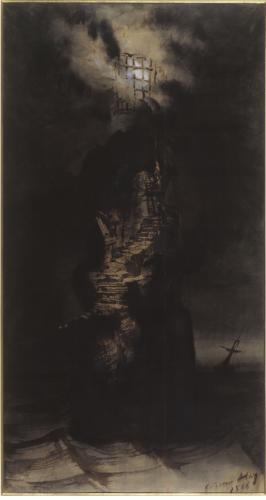THe Iris
'Immortality', 'Stairway to Heaven', 'Autumn Leaves', 'Royal' & the Caparne cultivars
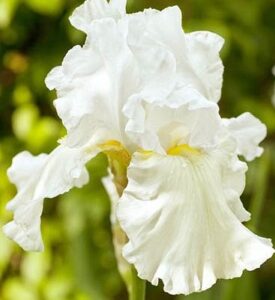
When it comes to the question of the immortality of the soul, you can see the why, you can’t see the how.
Post-scriptum de ma vie, published 1901
‘Guernsey, 10 August 1856, 3.45 Sunday afternoon.
… Today is my poor [daughter] Claire’s birthday and all morning I have been denuding kind Mme Le Boutillier’s garden of its white flowers so I can place them in front of the portraits of that dear absent one. If, as you believe, those dear souls who have taken flight wander amongst us between the sky and the earth, they must be trying to contact us in the forms we like best, and it is perhaps their breath that we breathe in the perfume of flowers. Every time my lips come near a white rose I seem to feel my child’s kisses, and often it seems as though some sweet bird that flies close past me says to me, on the wing, those two holy syllables: mother. I have my own little reincarnation too, as you see; here you are, my dear beloved, here you are, I bless you, I am happy. I love you.’
Juliette Drouet to Victor Hugo*
Iris ‘Immortality’ is a pure white bearded iris bred in 1989 by Lloyd Zurbrigg (1925-2005) who was Professor of Music at Radford, Virginia, USA. It gains its name from the fact that it blooms twice in a season, very unusual for a bearded iris.
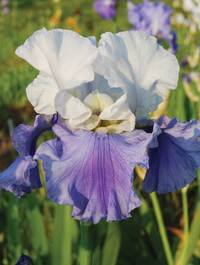
The immensity of the Being, the eternity of the Soul (L’immensité de l’être, l’éternité de l’âme), a quotation from Les Contemplations carved on a seat in Hauteville House garden
In another poem from Les Contemplations of 1856, ‘I am made of shadow and of marble’, Victor Hugo describes the poet as being ‘the stairway Darkness’. It is the poet’s task to go down into the depths and to examine them, on behalf of humanity. He or she should then re-emerge into the light to teach the lessons of what has been discovered there. Simply put, Hugo divided the world into matter and air, roughly represented by darkness and light, and by being (matter) and the soul. Matter lies beneath us, and it is easy to slip down into it and be submerged, never to reach ‘God’ who is to be found above us. The earth and the sea all threaten to overwhelm us. Life is a struggle to defeat the worldly and natural forces that conspire to bring us down. The study of the ‘book of nature’ that God has given us, through the medium of poetry, encourages and aids us to strive for the Ideal. The fate of humanity and nature are one; good and bad can be found in everything: darkness and light are within the souls of all of us. Hugo, the poet, by questioning his own soul, is our mediator.
Victor Hugo designed his house in Guernsey, Hauteville House, as a kind of monumental poem, itself made ‘of shadow and of marble.’ This is made very obvious in the structure of the house, which is centred around a winding and narrow staircase. At the foot of the staircase the hall is very dark. As you proceed up the stairway, the dark wood is lightened by mirrors added by Hugo, the frames decorated by him with his ‘mysterious flowers’. Eventually the staircase passes through a corridor lined with bookshelves and up to the celebrated lookout, the glass room Hugo added to the house. Here Hugo was at one with nature, separated only by panes of glass. He appears to be perched over the void, close to God and his messengers, the birds. He represents this journey up to the light in a drawing he made of the Casquets lighthouse off Alderney.
The lighthouse is described in his 1869 novel, The Man who Laughs, in its original elementary form, a small fire kept burning under a grill. The drawing represents this ancient beacon, a ship perilously close to the rocks beneath, but Hugo adds to it a set of winding steps that lead from darkness and danger up to the source of a brilliant light. In this drawing we can see a representation of Hauteville House as a microcosm of the world, in the same way that Hugo is a representative of Everyman; Hugo’s journey to the light is our journey. The way upward is fraught with rocks and reefs, but even if we fail and must start again, we will be given infinite chances to reach our goal.
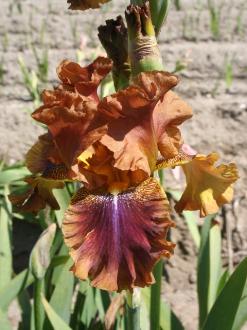
Les Feuilles d’automne, or Autumn Leaves, is a collection of poems published by Victor Hugo in 1831.
Iris ‘Autumn Leaves’ is a tall bearded iris that dates from the 1970s. It was bred by Keppel in Oregon, USA.
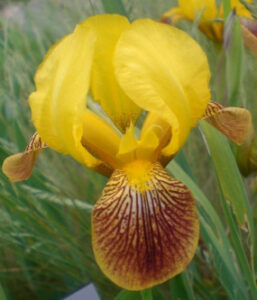
Caparne irises: Royal, Queen Flavia, Empress, King Christian
In the Walled Garden at Saumarez Park in Guernsey are conserved heritage cultivars and varieties of plants. The Victor Hugo Garden has been kindly provided with hollyhocks, heritage vegetables and these irises from the Walled Garden.
These special cultivars of iris were raised in Guernsey by the artist and plantsman William Caparne (1845-1922) in the late 1890s – early 1900s.
The American Iris Society named a medal after Caparne and thinks that the majority of dwarf bearded iris grown in any garden in the first quarter of the 20th century were probably a product of Caparne’s hybridising. In all he is estimated to have introduced as many as a hundred new iris varieties into cultivation. (Gardens Trust, see link below)
Caparne then turned his attention to the hybridisation of daffodils. A few fields of cultivated daffodils remain in Guernsey, although they have not been exploited for a century.
Although this postdates Victor Hugo’s time in Guernsey, his grandchildren Georges and Jeanne, who spent long holidays in the island, may well have been aware of these local flowers.
*For the letters of Juliette Drouet: www.juliettedrouet.org



